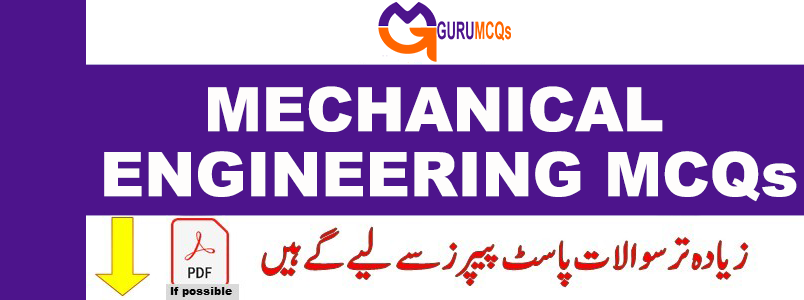
GuruMCQs.com provides all updated Mechanical Engineering Multiple Choice Questions (MCQs). The most frequently repeated mechanical MCQs section is frequently encountered in FPSC, PPSC, ETEA, NTS, Army, Navy, Air Force, educators, and various other competitive exams, as well as government and private job assessments. Most repeated mechanical engineering MCQs cover topics like Engineering Materials, Fluid Mechanics, Hydraulic Machines, Machine Design, Engineering Mechanics, Nuclear Power Plants, Steam Boilers, Engines, Nozzles, Turbines, Compressors, Gas Turbines, Jet Engines, Thermodynamics, Engineering Metrology, Heat Transfer, etc. Preparing with these MCQs can significantly contribute to your success in government job exams and interviews. Whether you are aiming to establish a career in engineering or seeking to enhance your existing skills, the Mechanical Engineering MCQs at www.gurumcqs.com serve as a valuable resource. Stay committed to regular practice and empower yourself with the knowledge needed to excel in your academic and professional endeavors.
61. According to fan laws, for fans having constant wheel diameter, the pressure varies________________?
A. directly as fan speed
B. square of fan speed
C. cube of fan speed
D. square root of fan speed
E. none of the above
62. Saving of work done and power by fitting an air vessel to single acting reciprocating pump is of the order of__________________?
A. 39.2%
B. 49.2%
C. 68.8%
D. 84.8%
E. 91.6%.
63. According to fan laws, for fans having constant wheel diameter, the air or gas capacity varies______________________?
A. directly as fan speed
B. square of fan speed
C. cube of fan speed
D. square root of fan speed
E. none of the above
64. Which place in hydraulic turbine is most susceptible for cavitation __________________?
A. inlet of draft rube
B. blade inlet
C. guide blade
D. penstock
E. draft tube exit
65. Specific speed for reaction turbines ranges from___________________?
A. 0 to 4.5
B. 10 to 100
C. 80 to 200
D. 250 to 300
E. none of the above
66. The discharge through a reaction turbine with increase in unit speed____________________?
A. increases
B. decreases
C. remains unaffected
D. first increases and then decreases
E. first decreases and then increases
67. Francis, Kaplan and propeller turbines fall under the category of___________________?
A. Impulse turbines
B. Reaction turbines
C. Axial flow turbines
D. Mixed flow turbines
E. Reaction-cum-impulse turbines
68. Francis turbine is best suited for_____________________?
A. medium head application from 24 to 180 m
B. low head installation up to 30 m
C. high head installation above 180 m
D. all types of heads
E. none of the above
69. Impulse turbine is generally fitted______________________?
A. at the level of tail race
B. little above the tail race
C. slightly below the tail race
D. about 2.5 m above the tail race to avoid cavitation
E. about 2.5 m below the tail race to avoid cavitation
70. In reaction turbine, draft tube is used_____________________?
A. to transport water downstream without eddies
B. to convert the kinetic energy to flow energy by a gradual expansion of the flow cross-section
C. for safety of turbine
D. to increase flow rate
E. none of the above
